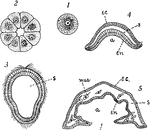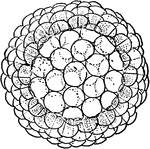Clipart tagged: ‘blastula’

Coral Stages
"Life history of a coral, Monoxenia darwinii. A, B, Ovum. C, Division into two. D, four-cell stage.…

Egg Germination
"Further development of hen's egg; after Haeckel: A, the mulberry mass of cleavage cells, b, same as…

Lancelet Stages
"Early stages in the development of Amphioxus. 1. Ovum with germinal vesicle; 2. four-cell stage; 3.…

Simple Sponge Development
"Diagrams to illustrate the development of one of the simpler types of sponge: I, the egg; 2, section…

Sponge Develoment
The sponge, a many celled animal, begins its life as a single-cell, the egg. The continued division…

Sponge Develoment
The sponge, a many celled animal, that begins its life as a single-cell, the egg. The continued division…

Sponge Develoment
The sponge, a many celled animal, begins its life as a single-cell, the egg. After division of cells…